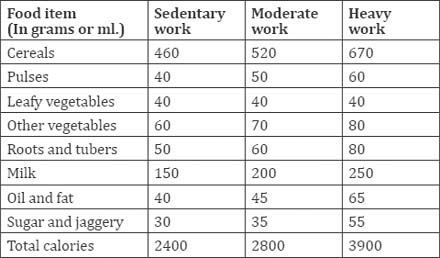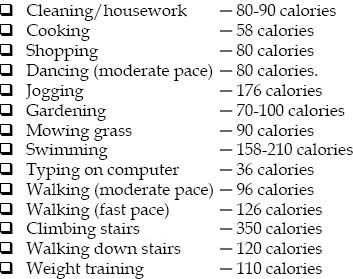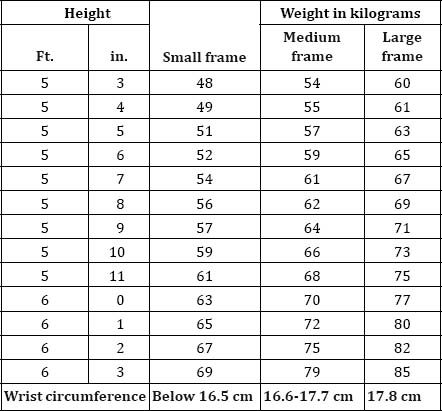

Not everybody likes to count calories when they are slimming because it involves quite a lot of accurate weighing and measuring, at least in the beginning. Most people like to opt for a simpler system where they divide various foods and drinks into certain categories, and have specific rules that tell them how to treat the items in these categories.
People who use this method of slimming cut out carbohydrates such as bread and potatoes. That is an effective method of slimming but is an unhealthy way to eat. Bread and potatoes are good sources of protein, nutrients and fibre as well as being a source of calories in the form of carbohydrate. The aim of a Cut Down diet should be to do without the empty calories in sugar and fats and high-calorie foods such as cakes and biscuits.
There are three categories in the Cut Out plan, and the food and drink items have been placed into categories following the general principles of healthy diet which is low in fat and cholesterol and sugar but provides sufficient proteins, vitamins, minerals and roughage.
The first category is the one containing the unrestricted foods and drinks. All of them have a low fat and sugar content and contain relatively few calories.
The second category is called ‘go carefully’, because you must limit your overall intake of these foods as suggested. These foods and drinks are not alarmingly high in fat or sugar when eaten in reasonable quantities and they will ensure that you do not go without any important vitamins, minerals and roughage. If you eat high-fibre wholemeal bread and cereals you take in more bulk for the same number of calories and so should find your food more satisfying.
The foods and drinks in the third category are the ones you must CUT OUT completely. They are the foods, which are either very high in fat, or very high in sugar content, or sometimes high in both. Cutting out these items from your diet will do no harm whatsoever; in fact it should improve your health considerably.
It would be very surprising if this diet did not involve a considerable reduction in your calorie intake if you follow it carefully, you should lose weight at roughly ½ to 1 kg. a week (more in the first week), and your health will certainly benefit in many ways.
 Liver, kidney, heart, brain
Liver, kidney, heart, brain
 Poultry (not duck)
Poultry (not duck)
 White fish and seafood
White fish and seafood
 All green vegetables such as lettuce, cabbage, beans etc.
All green vegetables such as lettuce, cabbage, beans etc.
 Root vegetables, such as carrots
Root vegetables, such as carrots
 All fresh fruit, except bananas and avocado pears
All fresh fruit, except bananas and avocado pears
 Cottage or curd cheese
Cottage or curd cheese
 Consomme, and low calorie soups
Consomme, and low calorie soups
 Water, black tea and coffee, low calorie drinks
Water, black tea and coffee, low calorie drinks
 Cream
Cream
 Butter, hard margarine, fats and oils
Butter, hard margarine, fats and oils
 Cream-cheese
Cream-cheese
 Fatty meats like pork, ham and Salami
Fatty meats like pork, ham and Salami
 Sugar, sweets and chocolates
Sugar, sweets and chocolates
 White bread (but not wholemeal or brown)
White bread (but not wholemeal or brown)
 Corn flakes, and non-wholemeal cereals
Corn flakes, and non-wholemeal cereals
 Honey, syrup, treacle, jam, marmalade, Fruit tinned in syrup
Honey, syrup, treacle, jam, marmalade, Fruit tinned in syrup
 Dried fruit
Dried fruit
 Crisps, savouries, nuts
Crisps, savouries, nuts
 Salad cream, mayonnaise
Salad cream, mayonnaise
 Rich creamy soups
Rich creamy soups
(No more than the indicated helping each day, and no more than four items from this category)


Proteins 1 gm per Kg of body weight per day.
By eating a 100 gm bar of milk chocolate about 660 calories are added to the daily total. If these are in excess of daily requirements, the length of time it takes to burn them off may make you think twice before indulging. If you don’t burn off the calories, they become body fat @ 85 grams per chocolate bar. Exercises will burn off calories – but it takes longer than you think. To indulge in an extra bar of chocolate without gaining extra weight, one of the following activities should be performed for the time shown.

Even though we do not realise it, our body is constantly burning calories. Something as mundane as cooking can burn up 58 calories in 20 minutes. Here is a chart of some such activities:

Some of the common excuses made by a fat person run along the lines of ‘it’s the glands’, ‘it’s my metabolism’ or ‘it runs in my family’. These excuses can all be considered together because they might all contribute partly to the fatness in some people (but not necessarily those who use them as an excuse).
Obesity due solely to the malfunctioning of one particular endocrine gland is very rare, probably accounting for only one in ten thousand cases. It has been said that the only glands, which are not working properly in a fat person, are the salivary glands, which work too well!
‘Metabolism’ is a very general term to describe the way in which food is turned into energy by the body, and studies of metabolic rate have indeed revealed vast differences between individuals, so that the amount of food they can eat without getting fat will also vary greatly. It has also been shown that individuals vary in their response to overeating. Some will gain the theoretically calculated amount of weight when they are over-fed while others will gain less than predicted. What exactly happens is not yet known.
The fact that obesity runs in families is a well-established one, however, it is so difficult to differentiate nature from nurture that it is difficult to say how valid an excuse it is. The studies of twins and adopted children which are usually undertaken to resolve this nature-nurture conflict give confusing results, although there is a definite indication that some generic factor plays a part.
In summary, it seems that some people do have a genetically inherited tendency to fatness, which manifests itself in metabolic changes. However, there is nothing to stop those with a tendency to fatness overcoming it, even though the task for them might be harder than it is for others.
Recently, scientists have been particularly interested in classifying fat people according to the age of onset of their obesity. This followed some reports in the early seventies that the child– onset obese had more fat cells than the adult-onset obese, and it was inferred by others that the child-onset obese would have greater problems with slimming as adults. The publicity given to this theory, while being useful in prevention of infantile and childhood obesity, has been harmful in another way; being fat as a child has become quite a common excuse for adults who cannot lose weight easily. There is no truth in this excuse because it has never been shown that the child-onset obese cannot lose weight.
Some teenagers and their parents use the term puppy fat to describe increased fatness during adolescent years. It is true that the changes in sex hormones during these years will lead to an increase in body fat in girls, but any over-eating during this time will lead to surplus body fat and this cannot be blamed on hormones.
Some women complain that they managed to maintain a reasonable weight until they went on the pill. Unfortunately there is no large scale survey which can validate this claim; usually, average weight-chances on different pills are given as zero as equal number of women loose weight on the pills as those that gain it. However it is known that pills that can result in weight gain can cause some fluid retention almost by about 3 kgs. If the weight gain is due to pills it is easy to identify the cause because as soon as the pill is stopped the weight gained is lost quickly. In case of weight gain due to pill, a change in the pill is recommended.
A lot of women will say that having children was their downfall as far as their weight was concerned. Here again, it is impossible to separate the physiological factors associated with pregnancy with the changes in lifestyle that usually accompanies pregnancy and the subsequent caring for children. A sensible weight-gain during pregnancy is between 9.5 to 12.5 kg. A weight-gain above the maximum limit will most certainly mean that the mother has added too much to her own fat-stores. Although it has never been shown that extra fat gained during pregnancy is different from normal fat, or that the mother’s metabolism alters appreciably, some women find that they never lose this extra fat. Mothers who have a second child soon after the first might find it particularly difficult to lose the fat without a positive effort, because they lose track of what it was like to have a normal figure.
It is true that a lot of people do put on weight when they stop smoking. A recent American survey showed that men who had given up smoking during a certain five-year period had gained much more weight on average than men who continued to smoke. However, this only shows an average trend and does not indicate that a weight-gain is a biological certainty. There is no evidence that smoking alters your metabolism by an appreciable amount, and those who do gain weight are often very willing to admit that they do eat more when they stop smoking, probably because they feel the need to have something in their mouth al the time. If this is your problem, try chewing low-calorie gum. It is generally agreed that smoking is a greater health risk than obesity, so it is worth making the effort to give up smoking.
The average weight of both men and women increases with age although there is no physiological reason why it should do so. More often than not, surplus fat accumulated gradually with age because of a gradual decline in physical activity coupled with perhaps an increase in food and drink consumption. Small changes in your lifestyle, such as taking the lift instead of walking up the stairs each time, can make quite a difference in the long term.
An ideal weight chart could help to pinpoint the goal one has to work towards, although the ideal weight would depend a lot on the build and bone density.


Some people, who begin dieting in earnest, give up half way because they find that their body weight remains constant after a certain amount of loss. This occurs due to a phenomenon known as the weight-loss plateau.
Weight-loss is not a consistent process. It has been seen that the loss is maximum during the first phase and then tapers down. This phenomenon is known as the weight loss Plateau. It is a temporary impasse, which could put damper on most slimmers. But it is a hurdle that needs to be crossed without being psychologically frustrated about it. The body goes through three stages during the fitness effort.
The first stage – this is the conditioning phase during which the unused muscles begin to tone up and pains and aches signal this workout. Adrenaline and other hormones begin to get triggered off. During this phase, the weight-loss is minimal because the body is adapting to new stimulus and the muscles are not yet efficient enough to burn off fat. It is essential to continue the effort in order to reach the second stage during which there is more visible effect.
The second stage – during this stage the body that has already become conditioned becomes more responsive because the muscles have gone through the toning process and are vascularised. Blood vessels open up, allowing more energy-giving oxygen to saturate muscle tissue, which begins the process of burning up accumulated fat. The vascularisation builds up your stamina, reduces fatigue in the skeletal muscles and flushes out toxins from the systems. Exercising does not bring too much strain and the effort required is much lesser. The kilos begin to melt away and there is a joyous feeling of success.
The third stage – this is the plateau stage when the body begins to slow down. The pumping of adrenaline slows a bit, and the body’s natural defence-mechanism compels the processes within to slow down. The weight loss becomes static and the visible changes halt. It is very easy to get disheartened and stop exercising. This is the stage that has to be dealt with patience and fortitude. The readiness to respond, the ‘high’ is effective only when sustained for limited periods. The body’s natural defences and balance are merely trying to prevent rapid-exhaustion. The trick lies in recognising the plateau stage, which simply means that the body is gearing up for a fitter stage. It does not mean that the fitness potential is exhausted so don’t ever make the mistake of giving up at this stage.
